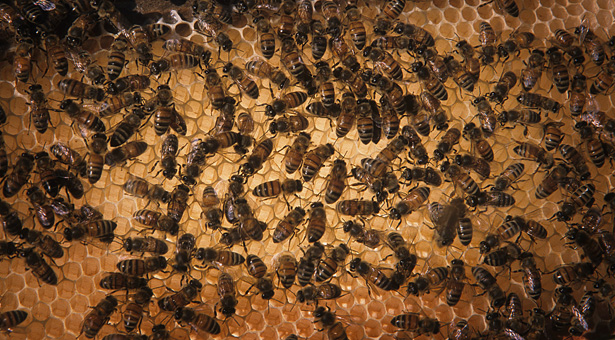How Do Bees Make Honey? (It’s Not Just Bee Barf)

Last weekend, my daughter asked me how bees made honey, and I realized that I didn’t know the answer. How do bees make honey? I did some homework, and can now explain it to her – and to you.
Different honey bees have different jobs. Some of these bees are “forager” bees, which collect nectar from flowering plants. The foragers drink the nectar, and store it in their crop, which is also called the honey stomach. The crop is used solely for storage, and the bee does not digest the nectar at all.
The forager bee then takes the nectar back to the hive, regurgitating the nectar directly into the crop of a “processor” bee at or near the entrance to the hive.
While the forager heads back to the flowers for more nectar, the processor bee takes the nectar to the honeycomb, which tends to be near the top of the hive, and regurgitates it into a hexagonal wax cell. But now the nectar needs to ripen.
The processor bees add an enzyme called invertase every time they regurgitate their nectar (and it takes many loads of nectar to fill a cell). The nectar consists largely of sucrose (table sugar) and water. The invertase breaks the sucrose down into two simpler sugars: glucose (blood sugar) and fructose (fruit sugar).
By definition, honey contains less than 18.6 percent water, but water usually makes up approximately 70 percent of nectar. During the ripening process, the bees “dry out” the nectar. One of the ways they do this is by fanning their wings, which creates airflow around the honeycomb and helps water evaporate from the nectar.
Once the nectar has ripened into honey, it contains so little water that no microbes can grow in it. That keeps it from becoming contaminated by bacteria or fungi. At this stage, the processor bees “cap” the cell with an airtight wax seal. If the cap is not airtight, the honey will absorb moisture from the air, making it susceptible to bacterial or fungal growth. (This is also why it’s important to screw the lid back on your jar of honey.)
Here are a few more honey-related questions and answers.
If microbes can’t grow in honey, why can’t babies have honey?
Children under the age of one shouldn’t eat honey because the honey can still contain botulinum spores. The spores can’t germinate inside the honey (it’s too dry), but they may become viable after the honey has been consumed – and infant immune systems may not be capable of warding them off.
Why do some types of honey crystallize more easily than others?
In addition to sucrose and water, nectars from different plants can hold varying amounts of other sugars and chemicals. (That’s why honeys from different plant sources have different flavors.) Nectars that have higher levels of glucose tend to crystallize more readily. Sourwood and tupelo honeys have lower levels of glucose, and so almost never crystallize.
How can I turn honey that’s crystallized back into a liquid?
If your honey has crystallized, put the jar of honey into a pot filled with hot (but not boiling!) water. This is better than microwaving it, because over-heating the honey can make it taste unpleasant.
Sweet, right?
Note: Many thanks to David Tarpy, associate professor of entomology at NC State and director of the Beekeeper Education & Engagement System, for taking the time to talk with me about bees and honey. Any errors in the above post are mine alone.


